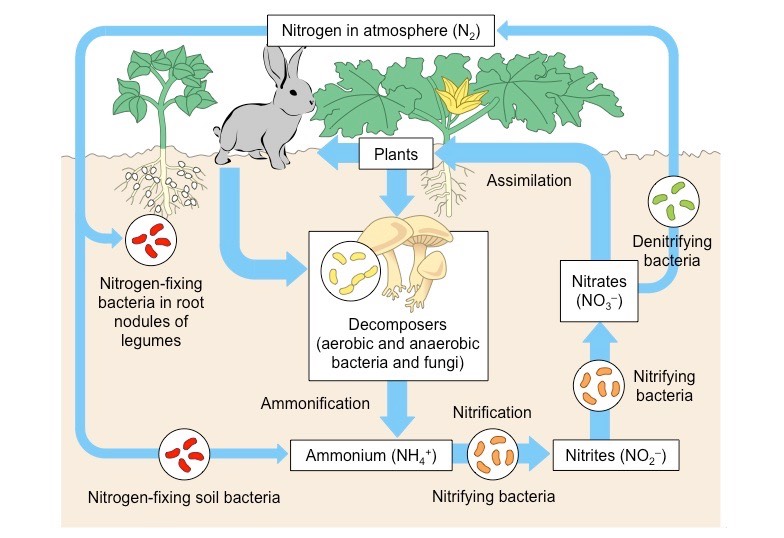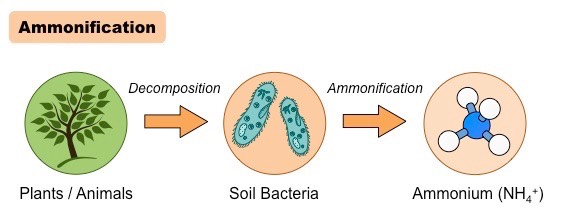![]()
Skill:
• Drawing and labelling a diagram of the nitrogen cycle
The nitrogen cycle is the biogeochemical cycle whereby nitrogen is converted into various chemical forms
- Whilst ~78% of the atmosphere is composed of nitrogen (N2), this gas is inert and unable to be used by plants and animals
- Chemoautrophic bacteria can convert this nitrogen gas into compounds that can be assimilated by plants and animals
The Nitrogen Cycle


⇒ Click on the diagram to show a simplied schematic
![]()
Understanding:
• Nitrogen-fixing bacteria convert atmospheric nitrogen to ammonia
• Rhizobium associates with roots in a mutualistic relationship
Nitrogen Fixation
The first stage of the nitrogen cycle is the conversion of inert nitrogen gas (N2) into ammonia (NH3)
- This reaction is catalysed by the enzyme nitrogenase, which is produced by nitrogen-fixing bacteria in the soil
- Azotobacter is found living freely in the soil, while Rhizobium forms a mutualistic association with the roots of legumes
- Rhizobium forms nodules within the plant roots and supplies ammonia to the plant in exchange for carbohydrates
- Ammonia (NH3) becomes ammonium (NH4+) when mixed with water, and this can be used by plants

Ammonification
Ammonia can also be produced from organic sources of nitrogen (e.g. amino acids) when broken down by decomposers
- As a plant or animal decays, saprotrophs will decompose organic materials to produce ammonia (and ammonium ions)
- This process is known as ammonification and releases ammonium ions into the soil which can be absorbed by plants

Nitrification
Nitrification is the conversion of ammonium ions into nitrites (NO2–) and nitrates (NO3–) by nitrifying bacteria in the soil
- Nitrosomonas converts ammonium ions into nitrites, while Nitrobacter can convert the nitrites into nitrates
- These reactions require oxygen and hence soil must be well aerated to ensure a rich supply of nitrites and nitrates
- Nitrites and nitrates are easier for plants to assimilate and hence function as a predominant source of nitrogen for plants

![]()
Understanding:
• In the absence of oxygen denitrifying bacteria reduce nitrate in the soil
Denitrification
Denitrification is a chemical reduction process that converts nitrates (NO3–) into nitrogen gas (N2)
- It is carried out by denitrifying bacteria (e.g. Pseudomonas denitrificans) in the absence of oxygen (i.e. anoxic conditions)
- Nitrates can be used instead of oxygen as an electron acceptor during cellular respiration, producing nitrogen gas
- This will only occur in oxygen-poor conditions (such as waterlogged soils) and reduces the availability of nitrates to plants

